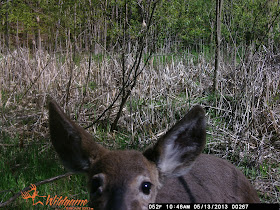Next week, I am working with students, parents, and staff to install a native pollinator garden at the
Morey Public School Academy. Morey PSA is a public charter school located between Winn and Shepherd, Michigan. This garden will be the third native pollinator garden that we have installed at local schools over the last three years. Each garden is composed mainly of prairie plants. It will be interesting to watch the progression of each garden over the next few years.
The first garden that we installed was at the
Saginaw Chippewa Academy The Saginaw Chippewa Academy is owned and operated by the
Saginaw Chippewa Indian Tribe in Mount Pleasant, MI. My wife currently teaches second grade at SCA. In 2011, she received a grant from the
Wildflower Association of Michigan to install this garden. We excavated and planted the entire garden over the course of one day with the help of fifth and sixth grade students. This is what the garden looked like the week of planting.
 |
| Saginaw Chippewa Academy Native Pollinator Garden - June 2011 |
Here it is later that summer.
And here is the SCA Native Pollinator Garden as of today.
 |
| SCA Native Pollinator Garden - May 2013 |
 |
| SCA Native Pollinator Garden - May 2013 |
 |
| Canada Anemone (Anemone canadensis) |
 |
| Hairy Beardtongue (Penstemon hirsutus) |
The second garden that we installed is at
Winn Elementary in Winn, Michigan. Winn Elementary is part of the
Shepherd Public Schools system.
It houses six classrooms K-5. I have a personal connection to Winn
Elementary - I spent part of my 4th grade year as a student at the
school. The garden at Winn was installed in June 2012. Funding for the project was provided in part by the Isabella Conservation District - the grant for our Environmental Education Program includes funding for schoolyard habitat improvements (like the new Native Pollinator Garden at Morey PSA). Additional funding came from the schools parent club. Thae garden was excavated and planted over the course of two day with help from students, staff, and parents.
This is what the garden looked like the day of installation.
 |
| Winn Elementary Native Pollinator Garden - June 2012 |
I don't have any good pictures of the garden from later last summer. This is what it looks like as of today.
 |
| Winn Elementary Native Pollinator Garden - May 2013 |
 |
| Winn Elementary Native Pollinator Garden - May 2013 |
 |
| Golden Ragwort (Packera aurea) |
I can hardly wait to get started on the next garden. It will be interesting to watch these gardens fill in over the next few years as the plants self-seed and spread.
Plants for all three of these projects were purchased from
Wildtype Native Plant Nursery in Mason, Michigan. Wildtype Nursery belongs to the
Michigan Native Plant Producers Association and produces plants from genotypes that are adapted for the Mid-Michigan area. I highly recommend the plants from Wildtype Nursery and have purchased many plants from there for my own gardens.
























































